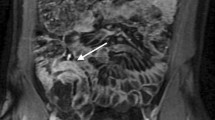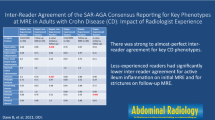Abstract
Purpose
To compare the content and accuracy of structured reporting (SR) versus non-structured reporting (NSR) for computed tomographic enterography (CTE) of inflammatory bowel disease (IBD).
Materials and methods
This IRB-approved, HIPAA-compliant, retrospective study included 30 adult subjects (15 male, 15 female; mean age 41.9 years) with IBD imaged with CTE. Nine radiologists (3 faculty, 3 abdominal imaging fellows, and 3 senior radiology residents) independently interpreted all examinations using both NSR and SR, separated by four weeks. Reports were assessed for documentation of 15 key reporting features and a subset of 5 features was assessed for accuracy. Thirty faculty reports (15 NSR [5 per reader] and 15 SR [5 per reader]) were randomly selected for review by three referring physicians, who independently rated quality metrics for each report.
Results
NSR documented the presence or absence of 8.2 ± 2.2 key features, while SR documented 14.6 ± 0.5 features (p < 0.001). SR resulted in increased documentation of 13 of 15 features including stricture (p < 0.001), fistula (p < 0.001), fluid collection (p = 0.003), and perianal disease (p < 0.001). Among a subset of five features, accuracy for diagnosing multifocal disease was minimally increased when using SR (76% NSR vs. 83% SR; p = 0.01), but accuracy for other features was not affected by report type. Referring physicians significantly preferred SR based on ease of information extraction (p < 0.01).
Conclusion
Structured reporting of CTE for IBD improved documentation of key reporting features for trainees and faculty, though there was minimal impact on accuracy. Referring physicians subjectively preferred the structured reports.



Similar content being viewed by others
References
European Society of Rad (2010) The future role of radiology in healthcare. Insights Imaging 1(1):2–11. doi:10.1007/s13244-009-0007-x
Radiological Society of North America (2016). RSNA radiology reporting initiative. Available at: http://reportingwiki.rsna.org/. Accessed November 30, 2016
Brook OR, Brook A, Vollmer CM, et al. (2015) Structured reporting of multiphasic CT for pancreatic cancer: potential effect on staging and surgical planning. Radiology 274(2):464–472. doi:10.1148/radiol.14140206
American College of Radiology (2014). Liver imaging reporting and data system. Available at: https://www.acr.org/Quality-Safety/Resources/LIRADS. Accessed February 1, 2017
Barentsz JO, Richenberg J, Clements R, et al. (2012) ESUR prostate MR guidelines 2012. Eur Radiol 22(4):746–757. doi:10.1007/s00330-011-2377-y
Radiological Society of North America (2016). Radreport. Available at: http://www.radreport.org/. Accessed November 30, 2016
Sistrom CL, Langlotz CP (2005) A framework for improving radiology reporting. J Am Coll Radiol 2(2):159–167. doi:10.1016/j.jacr.2004.06.015
Reiner BI, Knight N, Siegel EL (2007) Radiology reporting, past, present, and future: the radiologist’s perspective. J Am Coll Radiol 4(5):313–319. doi:10.1016/j.jacr.2007.01.015
Schwartz LH, Panicek DM, Berk AR, Li Y, Hricak H (2011) Improving communication of diagnostic radiology findings through structured reporting. Radiology 260(1):174–181. doi:10.1148/radiol.11101913
Sistrom CL, Honeyman-Buck J (2005) Free text versus structured format: information transfer efficiency of radiology reports. AJR Am J Roentgenol 185(3):804–812. doi:10.2214/ajr.185.3.01850804
Johnson AJ, Chen MY, Swan JS, Applegate KE, Littenberg B (2009) Cohort study of structured reporting compared with conventional dictation. Radiology 253(1):74–80. doi:10.1148/radiol.2531090138
Weiss DL, Langlotz CP (2008) Structured reporting: patient care enhancement or productivity nightmare? Radiology 249(3):739–747. doi:10.1148/radiol.2493080988249/3/739
Marcal LP, Fox PS, Evans DB, et al. (2015) Analysis of free-form radiology dictations for completeness and clarity for pancreatic cancer staging. Abdom Imaging 40(7):2391–2397. doi:10.1007/s00261-015-0420-110.1007/s00261-015-0420-1
Wildman-Tobriner B, Allen BC, Davis JT, et al. (2016) Structured reporting of magnetic resonance enterography for pediatric Crohn’s disease: effect on key feature reporting and subjective assessment of disease by referring physicians. Curr Probl Diagn Radiol . doi:10.1067/j.cpradiol.2016.12.001
Park MJ, Lim JS (2013) Computed tomography enterography for evaluation of inflammatory bowel disease. Clin Endosc 46(4):327–366. doi:10.5946/ce.2013.46.4.327
Baker ME, Hara AK, Platt JF, Maglinte DD, Fletcher JG (2015) CT enterography for Crohn’s disease: optimal technique and imaging issues. Abdom Imaging 40(5):938–952. doi:10.1007/s00261-015-0357-4
Leyendecker JR, Bloomfeld RS, DiSantis DJ, et al. (2009) MR enterography in the management of patients with Crohn disease. Radiographics 29(6):1827–1846. doi:10.1148/rg.29609551029/6/1827
Cooper VF, Goodhartz LA, Nemcek AA Jr, Ryu RK (2008) Radiology resident interpretations of on-call imaging studies: the incidence of major discrepancies. Acad Radiol 15(9):1198–1204. doi:10.1016/j.acra.2008.02.011
Ruchman RB, Jaeger J, Wiggins EF 3rd, et al. (2007) Preliminary radiology resident interpretations versus final attending radiologist interpretations and the impact on patient care in a community hospital. AJR Am J Roentgenol 189(3):523–526. doi:10.2214/AJR.07.2307
Lin E, Powell DK, Kagetsu NJ (2014) Efficacy of a checklist-style structured radiology reporting template in reducing resident misses on cervical spine computed tomography examinations. J Digit Imaging 27(5):588–593. doi:10.1007/s10278-014-9703-2
Collard MD, Tellier J, Chowdhury AS, Lowe LH (2014) Improvement in reporting skills of radiology residents with a structured reporting curriculum. Acad Radiol 21(1):126–133. doi:10.1016/j.acra.2013.10.007
Hofmann AF, Poley JR (1972) Role of bile acid malabsorption in pathogenesis of diarrhea and steatorrhea in patients with ileal resection. I. Response to cholestyramine or replacement of dietary long chain triglyceride by medium chain triglyceride. Gastroenterology 62(5):918–934
Sandborn WJ (2009) How to avoid treating irritable bowel syndrome with biologic therapy for inflammatory bowel disease. Dig Dis 27(Suppl 1):80–84. doi:10.1159/000268125
Maglinte DD, Gourtsoyiannis N, Rex D, Howard TJ, Kelvin FM (2003) Classification of small bowel Crohn’s subtypes based on multimodality imaging. Radiol Clin North Am 41(2):285–303
Sahni VA, Silveira PC, Sainani NI, Khorasani R (2015) Impact of a structured report template on the quality of MRI reports for rectal cancer staging. AJR Am J Roentgenol 205(3):584–588. doi:10.2214/AJR.14.14053
European Society of R (2011) Good practice for radiological reporting. Guidelines from the European society of radiology (ESR). Insights Imaging 2(2):93–96. doi:10.1007/s13244-011-0066-766
Kushner DC, Lucey LL, American College of R (2005) Diagnostic radiology reporting and communication: the ACR guideline. J Am Coll Radiol 2(1):15–21. doi:10.1016/j.jacr.2004.08.005
Powell DK, Lin E, Silberzweig JE, Kagetsu NJ (2014) Introducing radiology report checklists among residents: adherence rates when suggesting versus requiring their use and early experience in improving accuracy. Acad Radiol 21(3):415–423. doi:10.1016/j.acra.2013.12.004
Bosmans JM, Weyler JJ, De Schepper AM, Parizel PM (2011) The radiology report as seen by radiologists and referring clinicians: results of the COVER and ROVER surveys. Radiology 259(1):184–195. doi:10.1148/radiol.10101045
Naik SS, Hanbidge A, Wilson SR (2001) Radiology reports: examining radiologist and clinician preferences regarding style and content. AJR Am J Roentgenol 176(3):591–598. doi:10.2214/ajr.176.3.1760591
Author information
Authors and Affiliations
Corresponding author
Ethics declarations
Funding
No funding was received for this study.
Conflict of interest
The authors declare that they have no conflict of interest.
Ethical approval
This article does not contain any studies with human participants or animals performed by any of the authors.
Informed consent
Statement of informed consent was not applicable since the manuscript does not contain any patient data.
Rights and permissions
About this article
Cite this article
Wildman-Tobriner, B., Allen, B.C., Bashir, M.R. et al. Structured reporting of CT enterography for inflammatory bowel disease: effect on key feature reporting, accuracy across training levels, and subjective assessment of disease by referring physicians. Abdom Radiol 42, 2243–2250 (2017). https://doi.org/10.1007/s00261-017-1136-1
Published:
Issue Date:
DOI: https://doi.org/10.1007/s00261-017-1136-1




